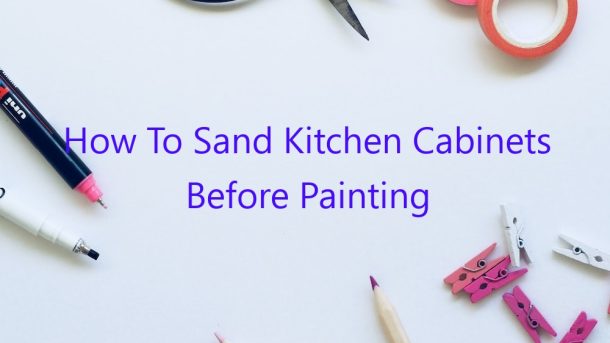If you’re planning on painting your kitchen cabinets, you’ll need to sand them first. This will remove any dirt, grease, or old paint and will help the new paint stick to the surface. Here’s how to do it:
1. Remove all of the cabinet doors and hardware.
2. Use a coarse sandpaper to sand the entire surface of the cabinets, including the edges. Start with a low grit sandpaper (60-80) and work your way up to a higher grit (150-220).
3. Be sure to sand in the direction of the wood grain.
4. Sand until all of the old paint and dirt is gone.
5. Wipe down the cabinets with a clean cloth to remove any dust or debris.
6. Let the cabinets dry completely before painting.
Contents
- 1 What grit should I use to sand cabinets before painting?
- 2 How much do you need to sand cabinets before painting?
- 3 What is the fastest way to sand cabinets?
- 4 What happens if you don’t sand kitchen cabinets before painting?
- 5 How do I get a smooth finish on kitchen cabinets?
- 6 How do you clean cabinets after sanding?
- 7 What kind of sander do you use for cabinets?
What grit should I use to sand cabinets before painting?
When preparing cabinets for painting, it is important to sand them down to create a smooth surface. The grit of sandpaper you use will determine how smooth the surface will be. In general, the higher the grit number, the smoother the surface.
Use a low grit number (between 60 and 80) for the initial sanding. This will help remove the finish and surface imperfections. Then, use a higher grit number (between 120 and 220) to achieve a smoother finish.
Be sure to sand in the direction of the wood grain to avoid leaving scratches. Also, be careful not to sand too aggressively, as this can damage the cabinet finish.
With a little bit of effort, you can create a smooth surface that is ready for painting.”
How much do you need to sand cabinets before painting?
When painting cabinets, it is important to ensure that the surface is properly prepped and sanded. This will help to ensure a smooth, even finish when the paint is applied. How much sanding is necessary before painting will vary depending on the condition of the cabinets. In most cases, however, a light sanding with a medium-grit sandpaper should be sufficient.
If the cabinets are in good condition and have a smooth finish, then a light sanding may be all that is necessary. However, if the cabinets are worn or have a rough finish, then a more thorough sanding may be required. In these cases, it is best to start with a coarse-grit sandpaper and then progress to a finer-grit sandpaper. Be sure to sand in the direction of the wood grain to avoid creating any scratches.
Once the cabinets have been sanded, it is important to clean them thoroughly before painting. This can be done with a damp cloth or with a cleaning product specifically designed for cabinets. Once the cabinets are clean and dry, the paint can be applied.
What is the fastest way to sand cabinets?
There are a few different ways that you can go about sanding cabinets. You can use a hand sander, an orbital sander, or a belt sander.
If you are using a hand sander, you will want to use a fine-grit sandpaper. Start by sanding in the direction of the wood grain. Then, sand in a circular motion to get into all the nooks and crannies. Finally, sand in the opposite direction of the wood grain to smooth it out.
If you are using an orbital sander, you will want to use a medium-grit sandpaper. Start by sanding in the direction of the wood grain. Then, sand in a circular motion to get into all the nooks and crannies. Finally, sand in the opposite direction of the wood grain to smooth it out.
If you are using a belt sander, you will want to use a coarse-grit sandpaper. Start by sanding in the direction of the wood grain. Then, sand in a circular motion to get into all the nooks and crannies. Finally, sand in the opposite direction of the wood grain to smooth it out.
What happens if you don’t sand kitchen cabinets before painting?
If you’re planning on painting your kitchen cabinets, one thing you definitely need to do is sand them first. Failing to do so can result in a number of problems, such as the paint not adhering properly to the surface, the finish looking patchy, and even the cabinets becoming damaged over time.
Sanding is an essential step in preparing cabinets for painting because it removes any built-up grease, dust, and dirt from the surface. This ensures that the paint will adhere properly and that the finish will look smooth and consistent.
If you don’t sand your cabinets before painting them, you may find that the paint doesn’t stick properly, resulting in it chipping and peeling off over time. The finish may also look patchy and uneven, and the cabinets may become scratched and damaged.
So if you’re planning on painting your kitchen cabinets, be sure to sand them first to ensure a smooth, even finish.
How do I get a smooth finish on kitchen cabinets?
Getting a smooth finish on kitchen cabinets is not as hard as it may seem, but it does take a bit of practice. The most important thing to remember is to take your time and to be patient.
The first step is to make sure that your cabinets are clean and free of any dust or dirt. Once they are clean, you can begin to sand them. Use a medium-grit sandpaper to sand the entire surface of the cabinets. Be sure to sand in the direction of the wood grain.
Once the cabinets are sanded, you can begin to apply a primer. Primer will help to seal the wood and will provide a smooth surface for the paint to adhere to. Be sure to apply a thin coat of primer and to sand it smooth before applying the paint.
Finally, apply a coat of paint to the cabinets. Again, be sure to apply a thin coat and to sand it smooth before applying a second coat.
If you take your time and are patient, you can achieve a smooth finish on your kitchen cabinets.
How do you clean cabinets after sanding?
When it comes to sanding cabinets, there are a few things you need to keep in mind in order to ensure a smooth, clean finish. One of the most important things is to clean the cabinets thoroughly after sanding.
There are a few ways to clean cabinets after sanding. One is to use a clean, damp cloth to wipe all of the dust and grit off of the cabinets. You can also use a vacuum cleaner with a brush attachment to clean them.
Another way to clean cabinets after sanding is to use a wood cleaner. Wood cleaners are available at most home improvement stores. They come in a variety of colors, and you simply need to apply it to the cabinets and let it dry.
Once the cabinets are clean, you can start to finish them. There are a variety of finishes available, such as paint, varnish, or lacquer. Choose the one that best suits your needs and your cabinets.
What kind of sander do you use for cabinets?
When it comes to sanding cabinets, there are a few different types of sanders that you can use.
The most common type of sander for cabinets is an orbital sander. An orbital sander is a small, hand-held sander that vibrates back and forth. It is a good choice for sanding large areas, such as cabinets.
Another type of sander that can be used for cabinets is a belt sander. A belt sander is a larger, heavier sander that uses a belt to sand surfaces. It is a good choice for sanding smaller areas, such as cabinet corners.
A third type of sander that can be used for cabinets is a drum sander. A drum sander is a large, heavy sander that uses a drum to sand surfaces. It is a good choice for sanding large areas, such as cabinets.
The type of sander that you use for cabinets will depend on the size of the cabinets, the type of finish that you are using, and your personal preference.




